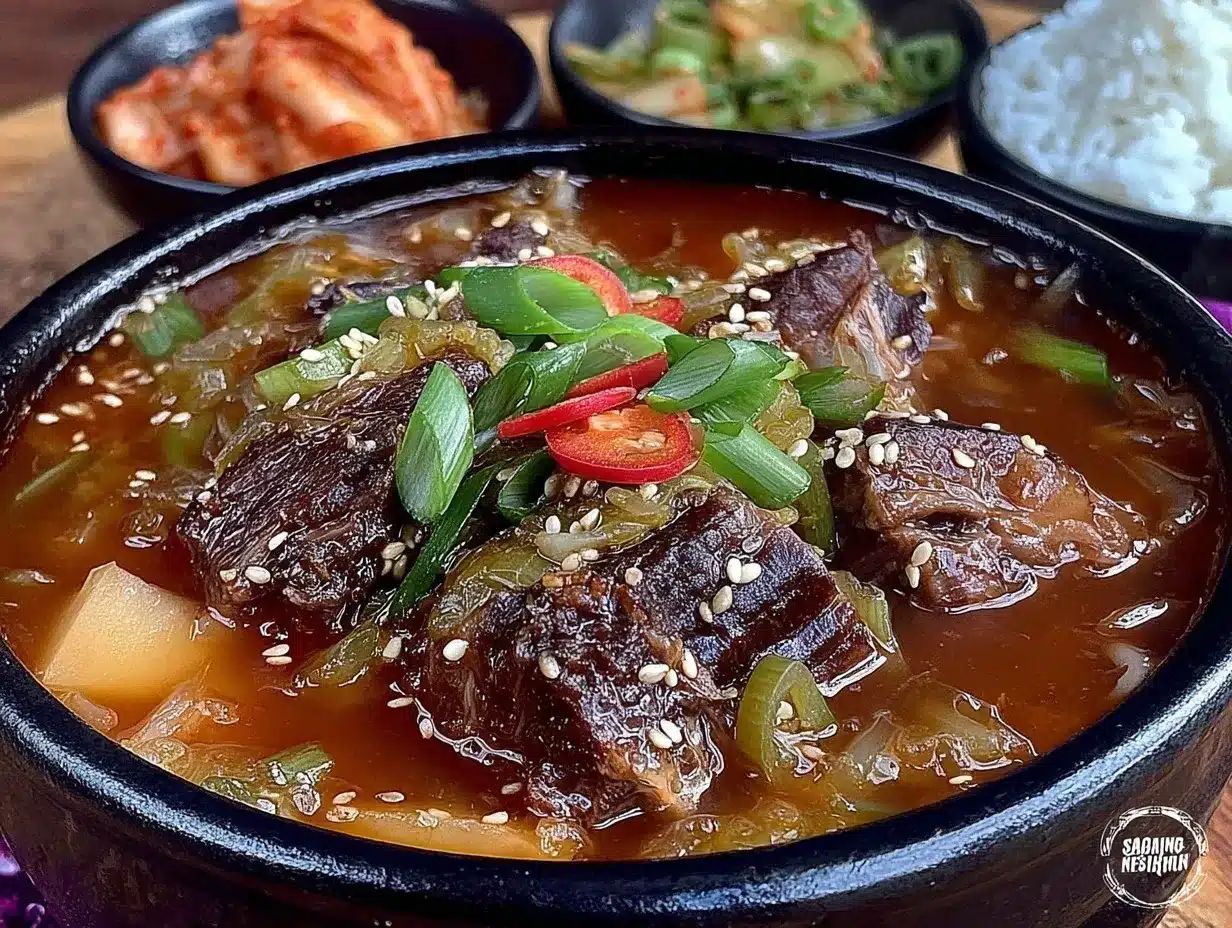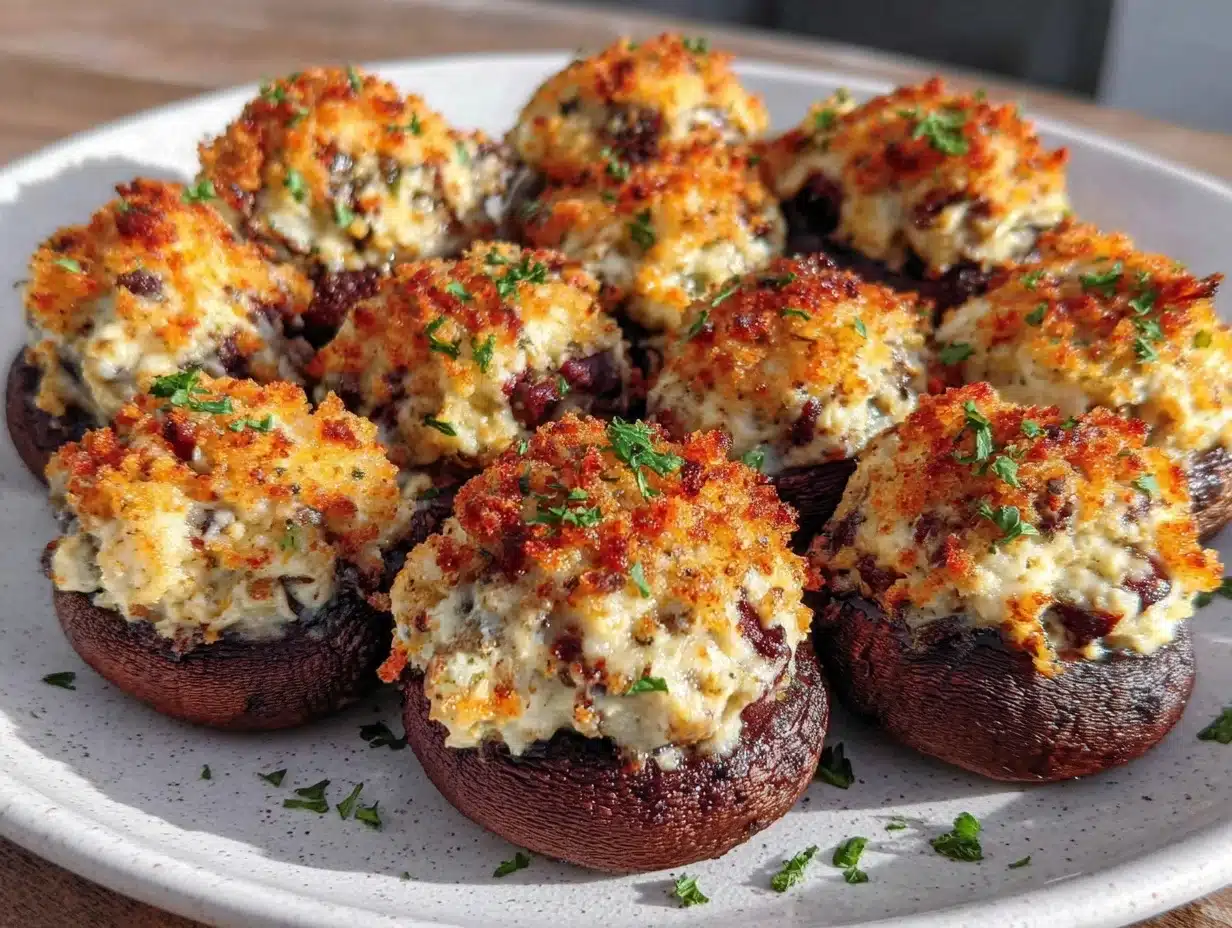The rich aroma of simmering beef bones, garlic, and fragrant spices wafting through my kitchen instantly makes me feel at home. Ppyeo Haejangguk, also known as Korean hangover soup, is my go-to remedy for mornings after a late night or whenever I need a bowl of comfort. With its hearty flavors and soothing warmth, this traditional dish is like a big hug in a bowl. It’s not just food—it’s therapy for the soul and the stomach.
I first discovered Ppyeo Haejangguk during a trip to Seoul. After a night filled with karaoke and soju, my Korean friends introduced me to this magical cure. Trust me, it works wonders! This isn’t just about curing hangovers; it’s about indulging in a deeply satisfying bowl of soup that makes you feel whole again. Whether you’re nursing a headache or simply craving something to warm you up, this recipe never disappoints.
What makes Ppyeo Haejangguk truly special is its simplicity and the way it transforms humble ingredients into bold, restorative flavors. It’s a dish that everyone should have in their kitchen arsenal, whether you’re battling the aftereffects of a party or seeking solace in a nourishing meal. Let’s dive into this comforting creation together!
Why You’ll Love This Recipe
- Authentic Korean Comfort Food: This recipe brings the classic flavors of Korea right to your table. It’s like a warm hug in a bowl!
- Perfect Hangover Cure: Packed with nutrients, this soup is designed to help your body recover after a night out. The collagen-rich beef bone broth is known for its restorative properties.
- Simple Ingredients: You don’t need any fancy or hard-to-find items; everything is easily sourced from your local grocery store or Asian market.
- Rich and Flavorful: The combination of tender beef, earthy vegetables, and bold Korean spices makes every bite unforgettable.
- Customizable: Whether you love it spicy or mild, there’s room to adapt this recipe to your taste buds.
What sets this Ppyeo Haejangguk recipe apart is its balance of flavors. The tender beef bones create a broth that’s not only delicious but also teeming with nutrients. Combined with napa cabbage, scallions, and a touch of gochugaru (Korean chili flakes), this soup is both invigorating and deeply satisfying.
It’s hearty enough to be a meal on its own, and the flavors are so comforting that you’ll find yourself making it even when you’re perfectly well. It’s not just a cure for hangovers but a celebration of traditional Korean flavors that leave you feeling nourished and content.
What Ingredients You Will Need
This recipe uses common kitchen ingredients and a few key Korean staples to create an authentic Ppyeo Haejangguk experience.
- Beef neck bones: The star of the show! These bones create a rich and flavorful broth filled with collagen.
- Napa cabbage: Adds a soft, slightly sweet texture and absorbs the broth beautifully.
- Bean sprouts: Crisp and refreshing, they balance out the richness of the soup.
- Garlic cloves: Minced or chopped to add depth and aroma.
- Gochugaru (Korean chili flakes): For a bit of heat and authentic flavor. Adjust the amount to your spice tolerance.
- Doenjang (fermented soybean paste): Adds umami and depth to the soup.
- Gochujang (red chili paste): For a spicy kick and a touch of sweetness.
- Scallions: Fresh and aromatic, they complement the soup beautifully.
- Salt and pepper: To taste, for seasoning.
- Water: To create the broth (about 10 cups, or adjust as needed).
Optional substitutions: If you don’t have beef neck bones, you can use oxtail or short ribs. For a milder flavor, reduce the amount of gochugaru or skip it altogether. For a vegetarian version, use mushrooms and vegetable broth instead of beef bones.
Equipment Needed
- Large stockpot: Essential for simmering the beef bones and making the broth.
- Strainer: To remove any impurities from the broth.
- Knife and cutting board: For chopping vegetables and preparing ingredients.
- Ladle: For serving the soup neatly.
- Bowls: Wide bowls work best to serve this hearty soup.
If you don’t have a stockpot, a slow cooker or Dutch oven can also work to simmer the bones. Just ensure it’s large enough to hold all the ingredients and water.
Preparation Method
- Prepare the beef bones: Rinse the beef neck bones under cold water to remove any impurities. Place them in a pot of boiling water for 5 minutes, then drain and rinse again. This helps create a cleaner broth.
- Simmer the broth: In a large stockpot, add the rinsed beef bones and 10 cups of water. Bring to a boil, then reduce the heat to a simmer. Allow it to simmer for 2-3 hours, skimming off any foam or impurities that rise to the surface.
- Add the vegetables: While the broth simmers, wash and chop the napa cabbage into bite-sized pieces. Rinse the bean sprouts thoroughly. During the last 30 minutes of cooking, add the cabbage and bean sprouts to the pot.
- Season the soup: Stir in 2 tablespoons of doenjang and 1 tablespoon of gochujang. Sprinkle in 2 tablespoons of gochugaru and add salt and pepper to taste. Adjust the seasoning as needed.
- Prepare the scallions: Chop the scallions into thin slices and add them to the pot just before serving for a fresh burst of flavor.
- Serve: Ladle the soup into bowls, making sure to include plenty of broth, vegetables, and tender meat. Serve hot and enjoy!
If your broth turns cloudy, don’t worry—it’s still delicious! The secret is to skim the foam regularly for a clearer finish. Also, don’t rush the simmering process; the slow cooking brings out the deep, rich flavors that make this soup so special.
Cooking Tips & Techniques
- Skim regularly: Removing foam from the top of the broth helps keep it clear and clean. Check every 15-20 minutes during the simmering process.
- Don’t skip the parboiling step: This removes impurities from the bones and ensures a clean, flavorful broth.
- Season gradually: Taste as you go! Korean flavors are bold, so adjust spices to suit your preference.
- Use fresh ingredients: Fresh garlic, napa cabbage, and scallions make a huge difference in flavor.
- Simmer patiently: Good things take time, and the longer you let the broth simmer, the richer it will be.
If you’re short on time, you can prepare the broth in a pressure cooker to speed things up. Just ensure it cooks long enough to extract all the flavors from the bones. Also, don’t be afraid to experiment with the spice levels—start mild and work your way up!
Variations & Adaptations
- Vegetarian version: Replace the beef bones with a mix of shiitake mushrooms and kombu (seaweed) to create a rich vegetable broth. Add tofu for extra protein.
- Spicy twist: Add more gochugaru or a dash of Korean chili oil for an extra kick.
- Seasonal ingredients: Swap out napa cabbage with kale or bok choy during winter months for a hearty seasonal variation.
- Gluten-free option: Ensure your doenjang and gochujang are certified gluten-free, or use miso paste as a substitute.
My personal favorite variation includes adding sliced daikon radish to the broth while it simmers. It adds a subtle sweetness and pairs beautifully with the beef bones.
Serving & Storage Suggestions
Serve your Ppyeo Haejangguk piping hot in wide bowls. Garnish with extra scallions or a sprinkle of sesame seeds for a touch of elegance. Pair it with steamed rice or kimchi for a complete meal.
For leftovers, store your soup in an airtight container in the refrigerator for up to 3 days. To reheat, simply bring it to a gentle simmer on the stove until heated through. You can also freeze the soup for up to 3 months. When reheating frozen soup, thaw it in the refrigerator overnight and warm it on the stove.
Pro tip: The flavors of this soup deepen and meld together after a day in the fridge, making it even more delicious the next day!
Nutritional Information & Benefits
Ppyeo Haejangguk is packed with nutrients! The beef bone broth is rich in collagen, which is great for skin and joint health. It’s also loaded with protein from the beef and vitamins from the vegetables, making it a balanced and nourishing meal.
It’s naturally gluten-free (provided your soybean paste is gluten-free), and you can adjust the spice level to suit your preferences. However, if you have soy allergies, you’ll want to skip the doenjang and gochujang or use alternative seasonings.
Conclusion
If you’re in need of a comforting, hearty meal that soothes the soul and revives the body, this Ppyeo Haejangguk recipe is calling your name. Whether you’re new to Korean cooking or a seasoned expert, this dish is a must-try. It’s the kind of recipe that brings people together—over hangovers, chilly evenings, or simply a love of good food.
I hope you enjoy every spoonful of this delicious hangover soup as much as I do. Don’t forget to make it your own by adjusting the spice levels or trying one of the variations. Leave me a comment below with your thoughts or how you customized the recipe—I’d love to hear from you!
Now, grab your stockpot and get this soup simmering. Trust me, you’ll be glad you did!
FAQs
What does Ppyeo Haejangguk mean?
Ppyeo Haejangguk translates to “hangover soup with beef bones” in Korean. It’s traditionally enjoyed as a remedy after drinking.
Can I make this soup without beef bones?
Yes, you can use oxtail or short ribs as a substitute, or make a vegetarian version using mushrooms and vegetable broth.
How spicy is this soup?
The spice level is adjustable. Add less gochugaru and gochujang for a milder flavor, or more for extra heat.
What can I serve alongside this soup?
Steamed rice, kimchi, or pickled vegetables are great sides to complement the flavors of Ppyeo Haejangguk.
Is this soup freezer-friendly?
Yes! Store leftovers in an airtight container in the freezer for up to 3 months. Thaw and reheat gently on the stove when you’re ready to enjoy.
Pin This Recipe!

Comforting Ppyeo Haejangguk Recipe to Cure Hangovers Easily
- Total Time: 3 hours 15 minutes
- Yield: 4 servings 1x
Description
Ppyeo Haejangguk, also known as Korean hangover soup, is a hearty and comforting dish made with beef bones, vegetables, and bold Korean spices. It’s perfect for curing hangovers or enjoying as a nourishing meal.
Ingredients
- 2 pounds beef neck bones
- 1 medium napa cabbage, chopped
- 2 cups bean sprouts
- 6 garlic cloves, minced or chopped
- 2 tablespoons gochugaru (Korean chili flakes)
- 2 tablespoons doenjang (fermented soybean paste)
- 1 tablespoon gochujang (red chili paste)
- 4 scallions, chopped
- Salt and pepper to taste
- 10 cups water
Instructions
- Rinse the beef neck bones under cold water to remove impurities. Place them in a pot of boiling water for 5 minutes, then drain and rinse again.
- In a large stockpot, add the rinsed beef bones and 10 cups of water. Bring to a boil, then reduce the heat to a simmer. Allow it to simmer for 2-3 hours, skimming off any foam or impurities that rise to the surface.
- Wash and chop the napa cabbage into bite-sized pieces. Rinse the bean sprouts thoroughly. During the last 30 minutes of cooking, add the cabbage and bean sprouts to the pot.
- Stir in 2 tablespoons of doenjang and 1 tablespoon of gochujang. Sprinkle in 2 tablespoons of gochugaru and add salt and pepper to taste. Adjust the seasoning as needed.
- Chop the scallions into thin slices and add them to the pot just before serving for a fresh burst of flavor.
- Ladle the soup into bowls, making sure to include plenty of broth, vegetables, and tender meat. Serve hot and enjoy!
Notes
[‘Skim foam regularly during simmering for a clearer broth.’, “Don’t skip the parboiling step to remove impurities from the bones.”, ‘Taste and adjust seasoning gradually to suit your preference.’, ‘Use fresh ingredients for better flavor.’, ‘Simmer patiently to extract deep, rich flavors.’]
- Prep Time: 15 minutes
- Cook Time: 3 hours
- Category: Soup
- Cuisine: Korean
Nutrition
- Serving Size: 1 bowl
- Calories: 250
- Sugar: 4
- Sodium: 800
- Fat: 10
- Saturated Fat: 4
- Carbohydrates: 15
- Fiber: 3
- Protein: 20
Keywords: Ppyeo Haejangguk, Korean hangover soup, beef bone soup, Korean soup recipe, comfort food, hangover cure, traditional Korean dish











